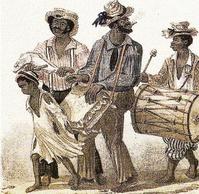Michael Robinson, Gleaner Writer

Band of the Jaw-Bone John-Canoe, Isaac Mendes Belisario - from Sketches of Character in Illustration of the Habits, Occupation and Costume of the Negro Population in the Island of Jamaica - 12 Lithographs, hand-coloured (Published in three fascicules 1837-1838).
The National Gallery continues a commemoration of the bicentenary of the abolition of slavery in Jamaica with an exhibition titled 'Isaac Mendes Belisario: Art and Emancipation in Jamaica'. Featuring paintings, engravings and prints by Belisario and some of his contemporaries, as well as authentic objects and artefacts from the 18th and 19th centuries, the display offers a view of the country at a crucial time of socio-political transformation.
The exhibit is a follow-up to 'Art and Emancipation in Jamaica: Isaac Mendes Belisario and His Worlds' which was mounted at Yale University's Centre for British Art, late last year. It comprises pieces from the original exhibit, many from Yale's holdings, as well as a number of pieces on loan from various Jamaican collections. Rarely and never-exhibited items make this groundbreaking exhibition a compelling experience as much as the vicarious glimpse into a Jamaica most people only know from historical anecdotes.
Little is known of the life of the show's headline artist, but his vision of colonial Jamaica is illuminating.
Belisario (1795-1849) was a Sephardic Jew and at the age of eight moved to England with his family where he studied art - an unusual choice of occupation for a male of Jewish heritage in the early 1800s. He worked as a stockbroker in London in the 1820s while practising as a portrait artist and, in 1831, showed one of his pieces at that city's Royal Academy of Arts.
Belisario returned to Jamaica at a time when the country's former slaves were transitioning from apprenticeship to full emancipation. He had a portrait studio on King Street, and also took commissions to paint estates. Popularly known as a watercolourist and lithographer, his estate oil paintings are more than competent. They present a tame view of apprentice labour against the rolling tranquillity of the landscape.
Elements of the exhibition
These images contrast sharply with other elements of the exhibition, such as ankle shackles and a gibbet. Images like 'West India Sportsman' (unknown artist) depicting a white man in a large hat being shaded and served by servants, accompanied by the quote: "Make haste with the Sangaree Quashee and tell Quaco to drive up the birds to me - I'm ready" give a wry take on the life of the slave-owner. The ease which they enjoyed was the result
of the sweat and blood of hard-working Africans.
Charles Tilt's (1797-1861) 'An Interior View of a Jamaica House of Corrections' is a more sobering look at the suffering endured during the colonial period. Outside of Belisario's idyllic estate views, whipping and wholesale torture had become an indelible part of the socio-political landscape.
Belisario also collaborated with Adolphe Duperly (1801-1864), a French printmaker, on projects like the series chronicling the 'Kingston Fire of 1843'. The three-print series captures a chaos and intensity that echo the underlying tensions in the city.
Serene views
Duperly is also represented in the exhibition by a series of images that portray serene views of Jamaican life. 'Market Falmouth', 'A View of King Street' and 'View of the Courthouse' (taken on the day of the election) were originally daguerreotypes that were taken to Paris and lithographed. The daguerreotype was a positive image produced by a photographic process using copper plates. The hand-coloured images retain the spirit of the scenes. A calmer Jamaica.
As a Jew, Isaac Belisario had some experience with oppression, and moved to Jamaica at a time when Jews had been granted more legal freedoms that weren't available in England. His lithographic series: 'Sketches of Character, In Illustration of the Habits, Occupation, and Costume of the Negro Population in the Island of Jamaica', published in 1837, represents an effort by the artist to produce work with more cultural significance.
Originally intentioned as a 12-part series, complete with subscribers - like today's commercial magazines, 'Sketches of Character' was produced four prints at a time. The first four were titled 'Christmas Amusements' and portrayed the costumed dances that merged African religious practices with European theatre and formed the basis for the re-emergence of Jonkonnu in the '50s.
While Belisario takes a conservative stance, portraying the positive side of the masquerades at a time when the ruling elite worried that these 'amusements' might precipitate violence and rebellion, his choice of subjects suggests a sympathetic view toward the oppressed. His anthropological depiction of Jamaica has become an iconic and invaluable contribution to Jamaican culture.
Alongside the placid works of Belisario, Duperly and JB Kidd (1808-1889), there is another Jamaica. Images like an etching of the Morant Bay Rebellion and 'First of August', a mezzotint by David Lucas combine with images of contemporary Jonkonnu performers and African sculptures to round out a comprehensive perspective of the island's post-colonial period.

